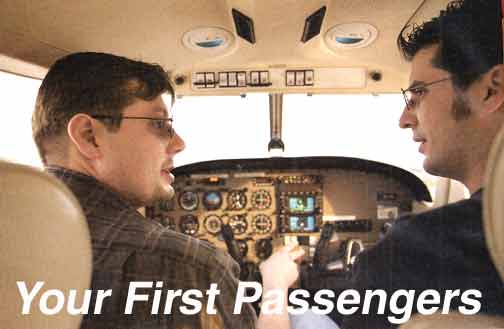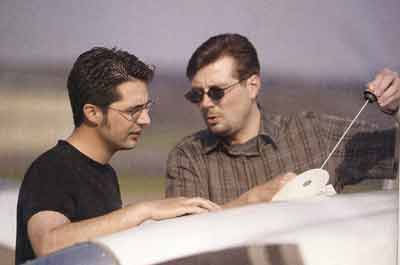
Budd Davisson
Flight Training, July, 2003
"A first airplane ride only happens once, so treat your first passengers nice"

Budd Davisson
Flight Training, July, 2003
About the only thing better than flying (the more obvious things excepted) is sharing the experience. Somehow, inviting someone into your world makes it seem that much more special. And that’s generally the first thing we do after getting our license: the ink is still wet on our license when we start badgering everyone we know into going flying with us in an effort to show them what we’ve just discovered. A few of us, however, let our excitement get the better of us and start the experience off with “…Wait’ll you see this!”
There is a reason airsick bag manufactures are thriving and we don’t want to contribute
to that business through our own thoughtless behavior.
The first time we do anything in life is always important, whether it’s our first kiss, our first solo or our first airplane ride. We carry that memory with us forever and when we’re taking someone for their first little airplane ride we want to leave them with a pleasant memory, not a painful one.
The number one rule of taking up our first passengers is to be as empathetic as possible. Put yourself in their place. You were there once. Try to remember what it was like to be inserted into a truly three-dimensional world where you are suspended in space by a machine that makes strange noises and has no visible means of support. Let’s face it troops; it can be pretty scary. Making matters worse, part of the population views “little airplanes” as being unsafe and unnecessary.
The more we fly, the harder it is to remember how it was at the beginning. Take rolling into an innocent bank, for instance. Nothing the average person has ever ridden in (airliners and roller coasters don’t count) would roll into a bank during a turn. They’ve never looked out the window and seen the ground out there on a wing tip. In an airliner that view bothers only a small number of people, but in a little airplane it feels like an unnatural act and many people react badly to it. To most it’s simply an uncomfortable feeling. To others it can set off all sorts of emotional alarms. If you don’t think flying along looking over your shoulder at the ground is an unnatural thing to do, notice how some of your passengers will instinctively lean away from the turn the instant you bank the airplane. Don’t laugh. You probably did it too in the beginning.
If you were to boil everything, which worries people about little airplanes down to a single phrase it would have to be “lack of understanding.” Assuming that this is their first ride and they are among your first passengers, then there is a major lack of understanding on their part that can be compounded by a minor lack of understanding on yours. We’ll get back to their lack of understanding in a minute but let’s focus on the new private pilot and what he or she either doesn’t understand or has forgotten.
A percentage of what you don’t understand about people you are taking for a ride goes back to the empathy thing. You have to put yourself in their shoes. But sometimes that’s difficult to do because you may have a basically different mindset than your passengers do, whether you know it or not.
In terms of mental make up, anyone who learns to fly is on the edge of the bell-shaped curve in a lot of areas. One of those areas is a willingness to try new things. You’re a little more adventurous than most. There’s also a possibility that you are more mechanically oriented and enjoy machines, although it’s not uncommon to run across pilots who don’t know squat about the machines they are flying. You also probably adapt to new situations and new environments quickly. We’re not pointing these things out because they make us superior beings. We’re pointing these out because the mental components that came together and made you want to become a pilot don’t necessarily exist within the general population. If they did, there would be more pilots.
If you were to boil everything that worries people about little airplanes
down to a single phrase it would have to be “lack of understanding.”
The differences in our thought patterns sometimes make it difficult for us to understand other people’s fears and anxieties. The longer a pilot flies, the better he becomes at recognizing when a person needs kid glove treatment. A brand new pilot hasn’t developed that understanding yet and, even if it’s there, it is sometimes over-ridden by their excitement at showing what they’ve just learned. It’s this urge to show what you know that sometimes leads to an uncomfortable flight for a passenger.
Going back to the passenger’s lack of understanding: most fear or apprehension of any kind in any situation is based on a fear of the unknown. This is another way of saying they don’t understand much of what is going on. If they did understand what was happening, it wouldn’t be unknown and their apprehension wouldn’t be as great. So, the best way to make them enjoy the flight is to work at eliminating the very cause of their difficulties, their lack of understanding. There are some things we can’t cure, like a fear of heights, but we can definitely explain things in enough detail that they’ll at least understand what’s going on, and in so doing, fear it less.
It’s not necessary a passenger know every little nit noid about the flight but a general understanding will go a long way and that can start with a gentle pre-flight briefing. You don’t have to make it a formal or intense affair (“…and then I’ll increase the back pressure and the nose will…”. In fact, the more rigid you make it, the more likely it is that it’ll raise apprehension, not lower it. Just make the flight and what they can expect part of your normal conversation as you get ready for the flight. Tell them a little about the airplane, “…this is a Cessna 172 and is probably the most common, most reliable airplane ever built. It is aviation’s Chevy.” Tell them a little about the operating environment, “…yeah, this is a busy airport, but I’ll be talking to the tower all the time and they’ll….” Try to give an image of what lies ahead without resorting to a chalkboard and bar charts.
To give a better understanding of the machine, have them peak over your shoulder while you’re doing a preflight. This will do two things; first, it will help them understand how the airplane flies and second, it will help paint a picture of you as being more professional. Don’t forget: most of those first passengers will be friends and family, none of whom will have ever seen you around an airplane. They only know you from their social contact with you and, for all you know, they think you’re a flake. Doing a thorough pre-flight with them watching should strengthen your image, which in turn will make them more comfortable with the flight.
 |